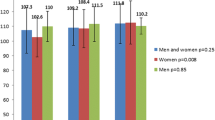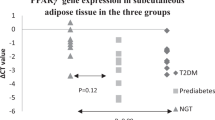Abstract
Our study aimed to analyze whether the expression of PPARγ mRNA in subcutaneous adipocyte tissue correlates with Pro12Ala PPARγ2 polymorphism in the obesity context. We found that mRNA expression of PPARγ in subcutaneous adipose tissue was greater in obese subjects (P < 0.05) than in the nonobese control group. Concurrently, genotyping of the Pro12Ala polymorphism showed that obese subjects possess a significantly higher frequency of the Pro/Pro genotype than nonobese controls (90.5 vs 79.5%; P = 0.03), suggesting that this genotype is involved in an increased risk of obesity in the Tunisian population. Taken together, our results demonstrate that the Pro12 allele is accompanied by an overexpression of PPARγ mRNA in subcutaneous adipocyte tissue, suggesting that the PPARγ Pro12Ala variant may contribute to the observed variability in PPARγ mRNA expression and consequently in body mass index and insulin sensitivity in the general population.


Similar content being viewed by others
References
Altshuler D, Hirschhorn JN, Klannemark M, Lindgren CM, Vohl MC, Nemesh J, Lane CR, Schaffner SF, Bolk S, Brewer C, Tuomi T, Gaudet D, Hudson TJ, Daly M, Groop L, Lander ES (2000) The common PPARγ Pro12Ala polymorphism is associated with decreased risk of type 2 diabetes. Nat Genet 26:76–80
American Diabetes Association (2004) Diagnosis and classification of diabetes mellitus. Diabetes Care 27(Suppl 1):S5–S10
Anghel SI, Wahli W (2007) Fat poetry: a kingdom for PPAR γ. Cell Res 17:486–511
Barak Y, Nelson MC, Ong ES, Jones YZ, Ruiz-Lozano P, Chien KR, Koder A, Evans RM (1999) PPARγ is required for placental, cardiac, and adipose tissue development. Mol Cell 4:585–595
Beamer BA, Yen CJ, Andersen RE, Muller D, Elahi D, Cheskin LJ, Andres R, Roth J, Shuldiner AR (1998) Association of the Pro12Ala variant in the peroxisome proliferator-activated receptor γ2 gene with obesity in two Caucasian populations. Diabetes 47:1806–1808
Ben Ali S, Ben Yahia F, Sediri Y, Sediri Y, Kallel A, Ftouhi B, Feki M, Elasmi M, Haj-Taieb S, Souheil O, Sanhagi H, Slimane H, Jemaa R, Kaabachi N (2009) Gender-specific effect of Pro12Ala polymorphism in peroxisome proliferator-activated receptor γ-2 gene on obesity risk and leptin levels in a Tunisian population. Clin Biochem 42(16–17):1642–1647
Bouhaha R, Meyre D, Kamoun HA, Ennafaa H, Vaillant E, Sassi R, Baroudi T, Vatin V, Froguel P, Elgaaied A, Vaxillaire M (2008) Effect of ENPP1/PC-1-K121Q and PPARγ-Pro12Ala polymorphisms on the genetic susceptibility to type 2 diabetes in the Tunisian population. Diabetes Res Clin Pract 81:278–283
Clement K, Hercberg S, Passinge B, Galan P, Varroud-Vial M, Shuldiner AR, Beamer BA, Charpentier G, Guy-Grand B, Froguel P, Vaisse C (2000) The Pro115Gln and Pro12Ala PPAR γ gene mutations in obesity and type 2 diabetes. Int J Obes Relat Metab Disord 24:391–393
Cristancho AG, Lazar MA (2011) Forming functional fat: a growing understanding of adipocyte differentiation. Nat Rev Mol Cell Biol 12(11):722–734
Deeb SS, Fajas L, Nemoto M, Pihlajamäki J, Mykkänen L, Kuusisto J, Laakso M, Fujimoto W, Auwerx J (1998) A Pro12Ala substitution in PPARγ2 associated with decreased receptor activity, lower body mass index and improved insulin sensitivity. Nat Genet 20:284–287
Fajas L, Auboeuf D, Raspé E, Schoonjans K, Lefebvre AM, Saladin R, Najib J, Laville M, Fruchart JC, Deeb S, Vidal-Puig A, Flier J, Briggs MR, Staels B, Vidal H, Auwerx J (1997) The organization, promoter analysis, and expression of the human PPARγ gene. J Biol Chem 272:18779–18789
Hamann A, Münzberg H, Buttron P, Büsing B, Hinney A, Mayer H, Siegfried W, Hebebrand J, Greten H (1999) Missense variants in the human peroxisome proliferator-activated receptor-γ2 gene in lean and obese subjects. Eur J Endocrinol 141:90–92
Ibrahim MM (2010) Subcutaneous and visceral adipose tissue: structural and functional differences. Obes Rev 11:11–18
Kouidhi S, Jarboui S, Marrakchi R, Froidevaux MS, Seugnet I, Abid H, Bchir F, Brahem M, Demeneix B, Guissouma H, Elgaaied AB (2010) Adiponectin expression and metabolic markers in obesity and Type 2 diabetes. J Endocrinol Invest 34:e16–e23
Lindi V, Siveniues K, Niskanen L, Laakso M, Uusitupa M (2001) Effect of Pro12Ala polymorphism of PPARγ2 gene long-term weight change in Finnish non-diabetic subjects. Diabetologia 44:925–926
Lowe CE, O’Rahilly S, Rochford JJ (2011) Adipogenesis at a glance. J Cell Sci 124:2681–2686
Luan J, Browne PO, Harding AH, Halsall DJ, O’Rahilly S, Chatterjee VK, Wareham NJ (2001) Evidence for gene–nutrient interaction at the PPARγ locus. Diabetes 50:686–689
Marita AR, Sarkar JA, Rane S (2005) Type 2 diabetes in non-obese Indian subjects is associated with reduced leptin levels: study from Mumbai, Western India. Mol Cell Biochem 275:143–151
Memisoglu A, Hu FB, Hankinson SE, Manson JE, De Vivo I, Willett WC, Hunter DJ (2003) Interaction between a peroxisome proliferator-activated receptor γ gene polymorphism and dietary fat intake in relation to body mass. Hum Mol Genet 12(22):2923–2929
Mori Y, Kim-Motoyama H, Katakura T, Yasuda K, Kadowaki H, Beamer BA, Shuldiner AR, Akanuma Y, Yazaki Y, Kadowaki T (1998) Effect of the Pro12Ala variant of the human peroxisome proliferator-activated receptor γ 2 gene on adiposity, fat distribution, and insulin sensitivity in Japanese men. Biochem Biophys Res Commun 251:195–198
Nicklas BJ, Rossum EFC, Berman DM, Ryan AS, Dennis KE, Shuldiner AR (2001) Genetic variation in the peroxisome proliferator-activated receptorγ2 gene (Pro12Ala) affects metabolic responses to weight loss and subsequent weight regain. Diabetes 50:2172–2176
Rocchi S, Auwerx J (2000) Peroxisome proliferator-activated receptor-γ, the ultimate liaison between fat and transcription. Br J Nutr 84(Suppl 2):S223–S227
Ruschke K, Fishbein L, Dietrich A, Klöting N, Tönjes A, Oberbach A, Fasshauer M, Jenkner J, Schön MR, Stumvoll M, Blüher M, Mantzoros CS (2010) Gene expression of PPARγ and PGC-1α in human omental and subcutaneous adipose tissues is related to insulin resistance markers and mediates beneficial effects of physical training. Eur J Endocrinol 162(3):515–523
Spiegelman BM (1998) PPAR-γ: adipogenic regulator and thiazolidinedione receptor. Diabetes 47:507–514
Tontonoz P, Spiegelman BM (2008) Fat and beyond: the diverse biology of PPAR γ. Annu Rev Biochem 77:289–312
Tontonoz P, Hu E, Spiegelman BM (1994) Stimulation of adipogenesis in fibroblasts by PPAR γ 2, a lipid-activated transcription factor. Cell 79(7):1147–1156
Valve R, Sivenius K, Miettinen R, Pihlajamaki J, Rissanen A, Deeb SS, Auwerx J, Uusitupa M, Laakso M (1999) Two polymorphisms in the peroxisome proliferator-activated receptor-fat and beyond: the diverse biology of PPAR γ gene are associated with severe overweight among obese women. J Clin Endocrinol Metab 84:3708–3712
Vernochet C, Peres SB, Farmer SR (2009) Mechanisms of obesity and related pathologies: transcriptional control of adipose tissue development. FEBS J 276(20):5729–5737
Westerink J, Visseren FL (2011) Pharmacological and non-pharmacological interventions to influence adipose tissue function. Cardiovasc Diabetol 10(1):13
White UA, Stephens JM (2010) Transcriptional factors that promote formation of white adipose tissue. Mol Cell Endocrinol 318(1–2):10–14
Zhu XY, Zhang XZ, Xu L, Zhong XY, Ding Q, Chen YX (2009) Transplantation of adipose-derived stem cells overexpressing hHGF into cardiac tissue. Biochem Biophys Res Commun 379:1084–1090
Author information
Authors and Affiliations
Corresponding author
Additional information
R. Berhouma and S. Kouidhi contributed equally to this study.
Rights and permissions
About this article
Cite this article
Berhouma, R., Kouidhi, S., Ammar, M. et al. Correlation of Peroxisome Proliferator-Activated Receptor (PPAR-γ) mRNA Expression with Pro12Ala Polymorphism in Obesity. Biochem Genet 51, 256–263 (2013). https://doi.org/10.1007/s10528-012-9560-y
Received:
Accepted:
Published:
Issue Date:
DOI: https://doi.org/10.1007/s10528-012-9560-y




